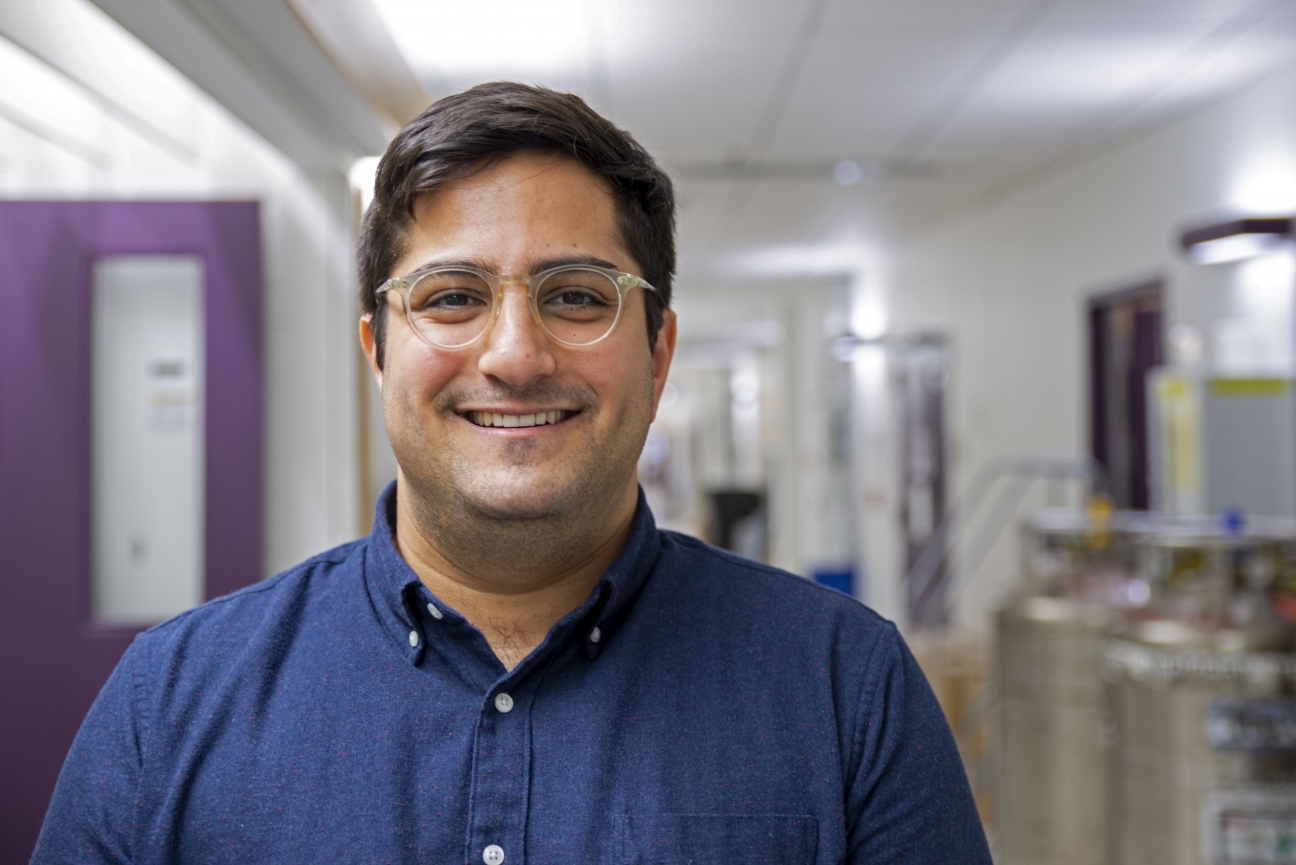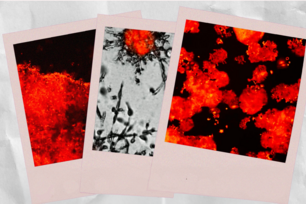
Whitehead Institute postdoc Benjamin Sabari
Image: Conor Gearin/Whitehead Institute
Meet a Whitehead Postdoc: Benjamin Sabari
Benjamin Sabari was a postdoc in Whitehead Institute Member Richard (Rick) Young’s lab investigating how the molecules involved in gene regulation organize into large collective assemblies called condensates. As of January 2020, Sabari is running his own lab at the University of Texas Southwestern Medical Center. We sat down with Sabari to learn more about him and his experiences in and out of the lab.
What did you investigate during your postdoc?
In Rick’s lab, we’re interested in how gene regulation is organized in the nucleus. Gene regulation is the process through which a gene that encodes for a protein or an RNA either does or does not get turned on. The way we had previously been thinking of this process was that individual molecules randomly move through the nucleus until they bump into each other, find specific regions of DNA, and from there begin transcribing RNA—i.e. turning on the gene. But when people looked at these processes in the cell, instead of individual molecules at work they saw hundreds or thousands of molecules clustering together at specific parts of the nucleus in a dynamic way, which was counterintuitive to what we had been thinking. We wanted to know what was causing the transcription molecules to collectively organize in this way. How were so many molecules clustering in specific areas? We found that the molecules were forming and gathering in droplets that we are calling condensates, or condensed phases of matter, which don’t have membranes but still form defined spaces in the nucleus. All of the machinery necessary to do the job of gene regulation appears in these condensates, and we think that condensates play an important and previously unrecognized role in gene regulation.
What are the translational implications of condensates being important for gene regulation?
The proteins involved in gene expression are implicated in many diseases, including cancer and neurodegeneration, so there’s a lot of excitement about gaining a better understanding of how they operate in the nucleus. When we were thinking about gene regulation as involving single molecules or complexes binding to particular portions of the genome, that forced researchers, including us, to focus on the structured regions of the proteins, which bind to DNA and one another in very specific ways, and ignore other regions. But the parts of the proteins that appear important for assembling transcriptional condensates are these floppier, disordered regions, and they have been essentially ignored by both biologists and medicinal chemists. The structured regions of protein are well understood, and we basically know how to develop drugs that block them from binding with their targets. Can we now achieve that same level of understanding for the unstructured regions of proteins, and tackle diseases through that? A number of companies, including some here in Kendall Square, are being founded now to tackle these big problems. So there's quite a lot of potential for how we could use what we've learned and are continuing to learn to treat human disease.
What did you want to be as a kid?
The first thing that I can remember wanting to be is a medical doctor. I had role models in my life who were doctors and I thought that was a really great career to have, where you’d be helping people. As I continued my training, I realized that there are other ways to help people, not through practicing medicine but through doing the early discovery research that can hopefully, eventually lead to breakthroughs in medicine. The idea of doing that kind of research, of discovering new things, ended up being more exciting to me and it’s the path I chose to pursue.
How did you end up at Whitehead Institute?
I did my graduate work at Rockefeller University in New York City and was looking for where to continue my training. Boston was always the center of the universe in a lot of ways for biology, and for how to take biology and apply it. All of these exciting things were going on in Kendall Square, so I always had in my head that Boston would be a great place to do part of my training in. I'd known of Rick Young through reading his papers and I got excited by the ideas that he was pursuing. So really, I was drawn to Whitehead Institute by my excitement for Rick and his lab.
What is it like to work on research that is cutting edge, and particularly on research that revises pre-existing scientific ideas in ways that some might view as contentious?
What Rick and us in the lab are trying to do is push the boundaries of what we understand, and every time you do that, especially when it's a topic that people are invested in and find interesting, you get a camp of people who become excited by the idea and then a camp of people who find a reason to push back. I think it's a fun place to be because the strength of feeling shows how much people care about the science. People get engaged and willing to debate topics, which creates this intellectually stimulating environment to work in. Because we’re all thinking about this problem together, the important questions and the important experiments become clear.
What’s the coolest thing you’ve ever seen in the lab?
We work a lot with proteins fused to green florescent protein (GFP), and just by naked eye they have this neon green color so you can see where the protein is. If you're doing any kind of chromatography or running gels, you can see the band of florescent protein without even staining it. You can also look at proteins under a florescent microscope. People trained in biochemistry, like me, don’t usually do that, but this project required us to because we're interested in how these proteins create these large, higher order collective assemblies. I remember the first time we did these experiments and took our protein preps and put them under the microscope—which, again, is this sort of bizarre thing for a biochemist to do—and seeing these droplets of protein, perfectly spherical, bouncing around and sometimes bumping into each other and fusing. That was a cool moment, to actually see these proteins and the droplets that they are able to form.
What’s the biggest disaster you’ve ever had in the lab?
My first month ever being in a lab, as an undergrad at the University of Rochester, I was helping out with this aging study where we were trying to analyze a large library of cell lines and then ask at what population doubling do they senesce. Basically, these cell lines needed to be cultured for a very long period of time. I was just learning how to do cell culture, and in some cell culture hoods, you can turn on the light or turn it to UV to sterilize the hood. You need to turn off the UV before you turn on the light so that you're not working under UV. You can see where this is going: I took these cells that the technician had been working with for months, and worked with them for thirty minutes under direct UV light. Not only did I get a sunburn on my arms, but I completely killed all of the cell lines I was working with. The technician was not happy. It was okay because the lab had planned for these types of things and had frozen down vials along the way. I'm glad that I got over that early failure and persisted because I was pretty bummed out at the time.
What is the Young lab like?
The lab is really a fun place with a great group of people. We're a team-oriented lab; we work in big teams. Everyone is willing to help out, troubleshoot experiments, or provide advice. We also have a good time when we’re not working. Every day we'll get lunch together in the cafeteria, have coffee, and joke around. On occasion, we'll go out as a group. It’s great just being with the people in the lab.
What are your hobbies outside of work?
I have a two-year-old daughter, so my wife and I pretty much spend all of our free time hanging out with her. It's an amazing, fun thing. Right now, she's really into Elmo and Curious George, and she's figured out a way to tell us about it and get us to let her watch it. She's just starting to put words together. It's very cute.
Where do you see yourself in ten years?
I'm starting my own lab at UT Southwestern in Dallas in January, so hopefully in ten years I'll have tenure at UT Southwestern, and be running my research group.
What lessons from your time at Whitehead Institute are you taking with you as you set up your own lab?
What I've learned from Rick's lab and Whitehead Institute in general is the importance of having really amazing people around you, and the impact that your community can have on your science. I've learned the power of working together with folks, and how that allows you to do the best work that you’re capable of. I think it’s also important to have fun and goof off together. A lesson I've learned throughout my career, that has definitely been true here, is to try to find yourself among company that helps you grow. That kind of environment just doesn’t happen on its own and it has to be fostered from the top down. I don’t know if I’ve figured out all the secrets, but I’m hoping to create that kind of environment in my new group.
Contact
Communications and Public Affairs
Phone: 617-452-4630
Email: newsroom@wi.mit.edu


